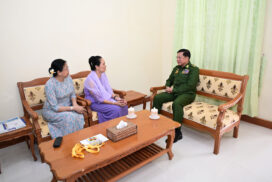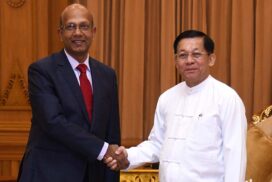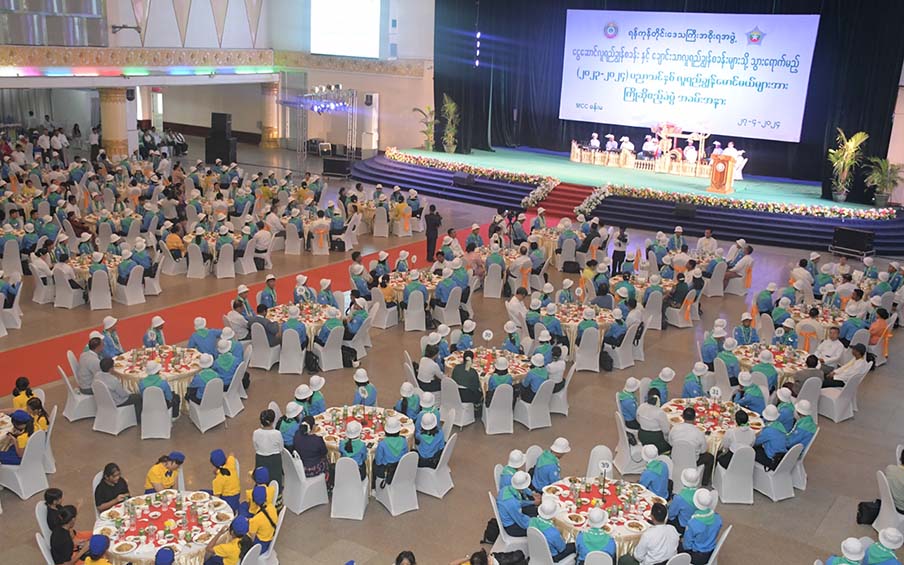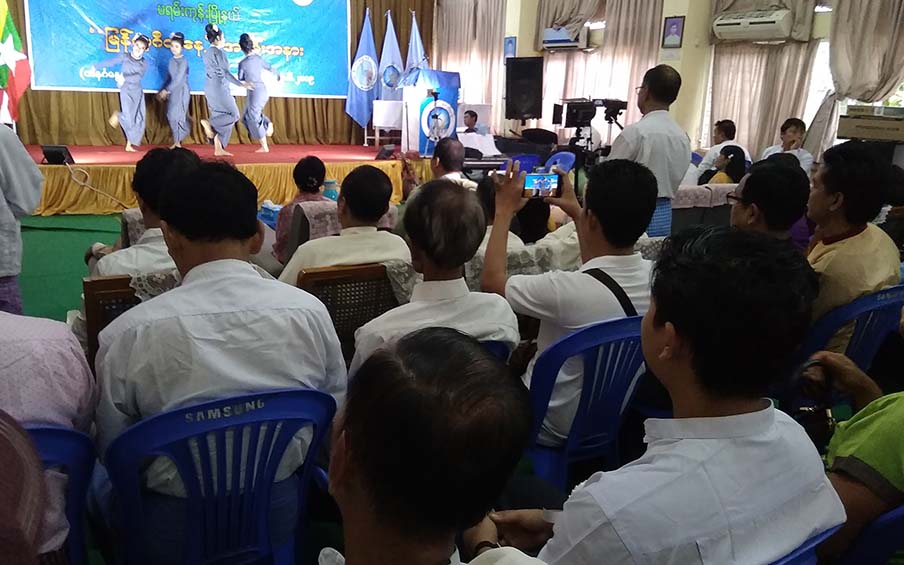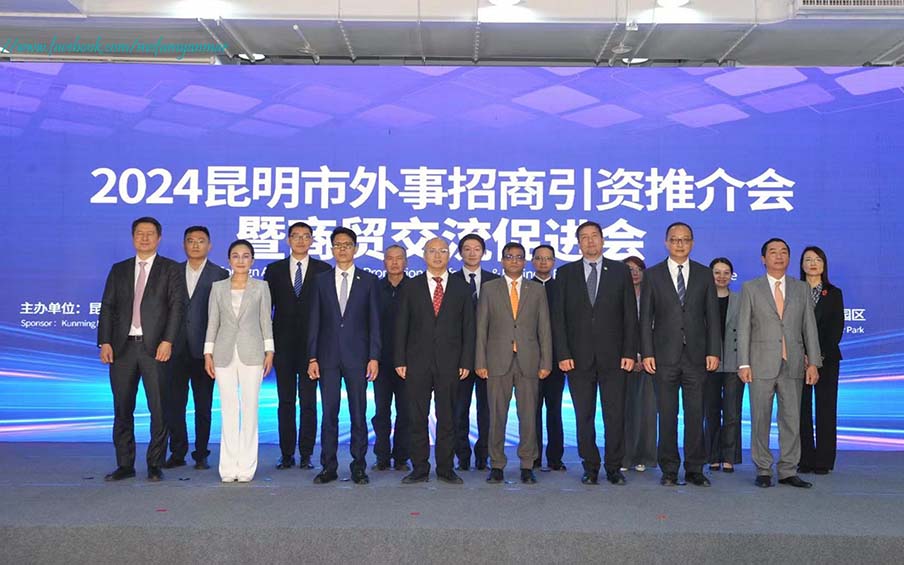R R Simpson, a mining specialist, returned from Burma on 3 April 1905. Posted to the United Provinces in connection with the Kangra earthquake investigation on the 8th idem, and returned to headquarters on 7 May 1905. Deputed to the Naga Hills, Assam, and left for the field on 8 November 1905 (GSI, 1905).
The Namma, Man-Sang and Man-Se-Le Coalfields, northern Shan States, Burma.
Before conducting the Namma, Man-Sang, and Man-Se-Le coal fields, Dr Fritz Noetling reported the Lashio Coalfield, northern Shan States and published in the Records of the Geological Survey of India (Vol XXIV, pt 2, p 99) in 1891. The boundaries of the coalfield were mapped in 1903 by Mr Datta, and in the season 1904-05, Mr Simpson was engaged during part of the time in making fresh excavations. He also discovered several previously unknown outcrops. T D LaTouche and R R Simpson reported the Lashio Coalfield in the Records of Geological Survey of India (Vol XXXIII, pt 2, p 117) in1905.
Due to space constraints, significant points from R R Simpson’s report on Namma, Man-Sang, and Man-Se-Le coalfields have been extracted in this article.
THE NAMMA COALFIELD
The Namma coalfield is situated in the Hsenwi and Hsipaw divisions of the northern Shan States. It is contained between latitudes 22° 36”- 22° 55’ and longitude 97° 42”-98° 2”, and extends within ten miles to the southeast of Lashio, the civil station of the northern Shan States, and the terminus of the Mandalay-Lashio Railway.
The principal axis of the coalfield follows a N-E – S-W direction and is about 15 miles in length. The average width is about 3 ½ miles, whilst the area contains some 50 square miles. A small outlier of the coal-bearing rocks is found three miles to the southwest of the main area. It is about four miles in length and probably not more than half a mile broad at the widest point. Its longer axis lies in the same direction as that of the larger area. The general elevation is from 1,500-1,800 feet above sea level. Thus, the area is sharply distinguished from the surrounding country, the average height of which is at least 1,000 feet greater, with summits exceeding 4,000 feet in height above sea level. The largest villages within the area are Manse (22° 48’- 97° 56’), on the north-east, and Namma (22° 43’- 97° 53’), on the southwest, from the latter of which the coalfield derives its name.
The coalfield was visited and reported on in 1890 by Dr Noetling, Geological Survey of India. During the field season 1902-03, Mr P N Datta, also of the Geological Survey of India, visited the coalfield. He has recorded the finding of a coal outcrop from 10 to 12 feet thick about one mile east of Namma and two or three outcrops of thin coal seams in the hilly ground about half a mile southwest of Namma.
Geology
The general geological features of a large portion of the Northern Shan States have been worked out chiefly by Mr T D LaTouche. Still, as the relations of the rocks found within the area under discussion are not yet fully established, no definite group names have been adopted throughout this paper. The rock formations found within the area under discussion are: –
AgeCharacter
4. Recent. Clays and conglomerates.
3. Pliocene? Clayey shales, sandstones,
conglomerates and coal seams.
2. Doubtful. Hard, purplish sandstones.
1. Earlier Palaeozoic. Blue and white limestones.
Earlier Palaeozoic: This formation is the lowest seen within the area. It consists of hard, blue or white limestone, occasionally shaly, but, as a rule, possessing a massive character. It has been extensively folded along an axis roughly coinciding with the longer axis of the coal-bearing rocks. As a consequence of this folding, the limestone has been, in many places, severely crushed, the particles having been subsequently recemented by calcite.
Rocks of doubtful age: These rocks are only seen on the east of the coalfield, where they consist entirely of hard, thin-bedded, much-jointed sandstones, purplish in colour. They appear to be unconformable to the limestone. Their dip direction varies from north to northeast, usually at an angle of about 30°.
The Tertiary beds: It is in these rocks that the coal seams occur. They consist of soft, whitish-yellow to light-brown, clayey shales- amongst which the coal seams are interbedded-soft, white or yellow sandstones and conglomerates. The latter is made up of boulders of yellow quartz, quartzite, and crystalline rocks, including granite. The fossils that have been found within the beds correspond closely with existing species, and from this fact, it has been inferred that the rocks are of Pliocene age.
Recent deposits: These consist of clays and conglomerates. The latter are derived from the disintegration of the Tertiary conglomerates and are most prominent in the bottoms of the valleys, where they form beds up to ten feet in thickness.
Quality of the coal
The coal of the Namma coalfield is a lustrous lignite with a specific gravity of 1.37. It is a bright black, and the streak is brown. It is non-coking and appears to be free from any large intermixture of iron pyrite. It is very hard but brittle, displays little or no cleavage, and breaks with a conchoidal fracture. The coal is very low in carbon, and the percentage of moisture and volatile products is very high.
So far as is known at present, there are only two coal seams of economic importance in the Namma coalfield. The Namma seam has been proved over an outcrop length of about 2,400 feet. It varies in thickness from about 7 to 17 feet and is variable also in quality.
THE MAN-SANG COALFIELD
This coalfield is situated in the neighbourhood of Man-sang (22° 26’; 97° 57’), a village lying 7 ½ miles due west of Mong Yai, the most important village in the South Hsenwi division of the northern Shan States and place of residence of the reigning Sawbwa of S Hsenwi. The northern end of the area lies sixteen miles S S E of the south-western end of the Namma coalfield.
The extent of the known area is 13 ½ square miles, but as the boundary on the south and southeast is ill-defined, the coalfield may be of greater extent than appears to be the case. The region is one of low, rolling hills with an average elevation of 2,800 feet. The same topographical features prevail for many miles to the south and southeast, but hills rising to a height of 4,500 feet above sea level are found in the north. There are no roads within the area, but the unmetalled cart road from Lashio to Tangyan passes within three miles of the northeastern boundary of the coalfield.
During the course of his economic survey of the northern Shan States in 1890, Dr Noetling apparently passed through the coalfield. In his report, he mentions the occurrence of “ a few beds of black, coal shale.”
Geology
Although no fossils were discovered, the age of the coal-bearing rocks is undoubtedly the same as those of the Lashio and Namma coalfields, i.e., late Tertiary, probably Pliocene. The geological features bear considerable resemblance to those of the above-mentioned coalfields. The essential difference is the presence of dolerite, which forms lofty hills to the north and occurs irregularly within the coalfield. Its relation to the Tertiary rocks is not apparent. No distinct evidence of intrusion was observed, and the coal rocks may have been laid down on an irregular surface of dolerite, portions of which have been exposed by denudation. The basement rock is the well-known Palaeozoic limestone, exposures of which are to be found in numerous places along the western boundary.
The recent deposits are chiefly of clay, but they include a conglomerate of dolerite boulders, which is very prominent about three miles from the northern boundary. The coal-bearing rocks are chiefly composed of yellow, white or grey shales with coal seams. The shales are occasionally sandy, and a thin band of sandstone was found in one place. The dip is inconstant. In the south, it varies from northwest to northeast at an average angle of 15°. As the northern boundary approaches, it alters to the southwest and south at 30°. It is again northerly close to the boundary, at angles of 30° to 50°.
Quality of the coal
The coal from this locality is a hard, somewhat shaly lignite with a specific gravity of 1.40. It varies from brown to black in colour and, although occasionally bright and lustrous, is usually dull in appearance. In general character, the coal resembles that from the Lashio and Namma coalfields and has the same undesirable quality of disintegration after exposure to air and sunlight.
So far as the recent explorations of the Man-sang coalfield have gone, no coal seam of a thickness greater than 4 ½ feet has been found. The continuity of the seams is uncertain, the dip very variable, and the area much broken up by dolerite intrusions. Even should this disadvantage not exist, it is unlikely that the coalfield will ever be of much economic value.
THE MAN-SE-LE COAL-FIELD
This small patch of coal-bearing rocks has hitherto escaped notice. It lies between 22° 37’- 22° 42’and 98° 13’- 98° 18’, and is situated 27 miles to ESE of the Namma coal-field. It is an irregular oval shape, the northern or longer axis being 4 ½ miles long, whilst the shorter axis is about a mile less. The total area is 13 ½ square miles. Its average elevation is 3,100 feet. The Lashio-Tangyan cart road passes within six miles of the southern boundary. The only villages of importance are Man-Se-Le (22° 40’- 98° 16’) and Kunglom (called Nam-hwin) (22° 39’- 98° 16’).
Geology
There is no doubt that the rocks of this coalfield are of the same age as those of the other known coalfields of the northern Shan States. The only fossils found are gastropods of a species identical to those found in the Namma coalfield. The boundary of the field, on all sides, is of Palaeozoic limestone. Yellow-brown shales with occasionally a sandy character are found within the area and coal seams. These rocks vary in dip from northeast to southeast at an average angle of 22°, with the highest angle of dip recorded being 40°. Here, as elsewhere, exposures are few and far between, the rocks being covered by the usual layer of alluvial clay.
Quality and quantity of fuel
Although it is by no means certain, it is probable that there are not more than one or two coal seams of importance in the field. Pits Nos 1 to 7 are all approximately on the same line of strike and are probably on one and the same seam. The greatest coal thickness was four feet, but even in this case, the top of the seam is denuded. Without further prospecting work, however, it would be unwise to hazard an opinion as to the quantity of workable coal.
The appearance of the coal is somewhat shaly, but the following analysis of a sample from No 2 pit shows it to be about equal in quality with that from the other fields, although inferior to the best Namma coal: Moisture (14.73 per cent), Volatile matter (38.83 per cent), Fixed Carbon (34.22 per cent), Ash (12.22 per cent).
The fact that the coal seam is probably of a small average thickness and is of inferior quality to that from the Namma area, together with the comparative inaccessibility of the locality, make it unlikely that the coalfield will be of economic importance for very many years to come.
References:
1. LaTouche T D and Simpson R R 1905; The Lashio Coalfield, northern Shan States, the Records of Geological Survey of India (Vol XXXIII, pt 2, p 117)
2. Simpson R R, Mining Specialist, 1905; The Namma, Man-sang and Man-se-le Coalfields, northern Shan States, Burma, Records of GSI (Vol XXXIII, Part 2, p 125)



